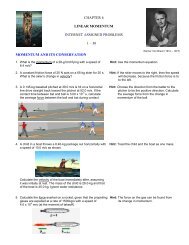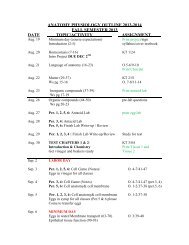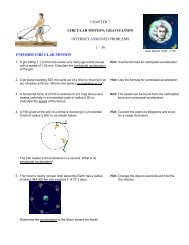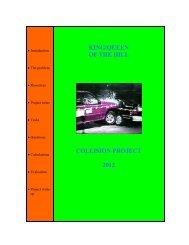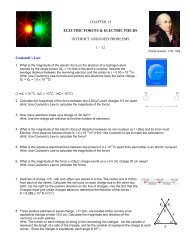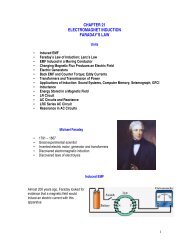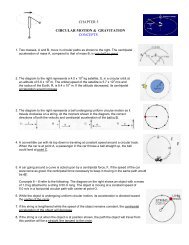Chapter 2 Motion in One Dimensions - Physics-matters.net
Chapter 2 Motion in One Dimensions - Physics-matters.net
Chapter 2 Motion in One Dimensions - Physics-matters.net
You also want an ePaper? Increase the reach of your titles
YUMPU automatically turns print PDFs into web optimized ePapers that Google loves.
NAME: _________________________ PER: _______ DATE: ________CHAPTER 2MOTION IN ONE DIMENSIONCONCEPTS QUESTIONS1. Ball A is dropped from the top of a build<strong>in</strong>g. <strong>One</strong> second later ball B is dropped. As timeprogresses the difference <strong>in</strong> their __________________________.2. An object’s velocity can change directions when its acceleration is constant. An example ofthis is when an object, like a ball, is ______________. The velocity is positive go<strong>in</strong>g up andnegative go<strong>in</strong>g down. The acceleration will rema<strong>in</strong> constant the entire time.3. <strong>Motion</strong> <strong>in</strong> the negative x direction is represented on an x vs. t plot by a _________________.4. Two objects are thrown from the top of a tall cliff. <strong>One</strong> is thrown up, and the other isthrown down, both with the same <strong>in</strong>itial speed. Ignore air resistance, when the balls hitthe ground they are ____________________________5. When a ball is thrown straight up, its acceleration at the top is ___________________6. Two balls are thrown straight up. The first ball is thrown with twice the <strong>in</strong>itial speed of thesecond. Ignore air resistance. The first ball will __________________ as far.7. Distance is to displacement as speed is to ____________________8. A horizontal l<strong>in</strong>e on an ______________________ versus time graph <strong>in</strong>dicates that theobject is at a constant acceleration.9. A horizontal l<strong>in</strong>e on a _______________ versus time graph <strong>in</strong>dicates that the object is at rest.10. Instantaneous speed is never _____________________.11. A ball, moves up along a smooth hill of ice will have the same acceleration, both _______ the hilland ___________ the hill.12. Galileo postulated that at a given location on the Earth and <strong>in</strong> the absenceof air resistance, all objects will fall with the ___________________________13. Acceleration is a vector quantity that represents the _______________________________14. If an object is travel<strong>in</strong>g east with a decreas<strong>in</strong>g speed, the direction of the object’sacceleration is ________________15. Objects A and B both start from rest. They both accelerate at the same rate. However, object Aaccelerates for twice the time as object B. Compared to the f<strong>in</strong>al ________ of object A to that ofobject B, object B is twice as fast.
16. An object can have <strong>in</strong>creas<strong>in</strong>g speed while its acceleration is decreas<strong>in</strong>g. An example would bean object released from rest <strong>in</strong> the ____________________________17. A horizontal l<strong>in</strong>e on a __________ versus time graph <strong>in</strong>dicates that the object is travel<strong>in</strong>g at aconstant velocity, which means zero acceleration.18. A ball is dropped from the top of a build<strong>in</strong>g. A second ball is thrown straight down from thesame build<strong>in</strong>g. They are released at the same time. Neglect<strong>in</strong>g air resistance the two balls_______________________________19. Oil drips at 0.5 second <strong>in</strong>tervals from a truck thathas an oil leak. The pattern shown represents thespac<strong>in</strong>g of oil drops as the car _______________uniformly from rest.20. An object is mov<strong>in</strong>g with constant acceleration <strong>in</strong> equal times its _________________________21. An object with zero acceleration ____________________________22. The distance time graph on the right represents the motion of an object slid<strong>in</strong>g down a_________________________________23. Objects A and B both start from rest. They both accelerate at the same rate. However, object Aaccelerates for twice the time as object B. Dur<strong>in</strong>g the times that the objects are be<strong>in</strong>gaccelerated, compar<strong>in</strong>g the _______ traveled by object A to that of object B, object Atravels ______________24. The slope of a velocity versus time graph gives ___________________________25. A mov<strong>in</strong>g object must undergo a change of ____________________26. The slope of a position time graph gives __________________________27. An object’s velocity can _______________________ when its acceleration is constant.Example, when a rock is thrown straight up.28. When a ball is thrown straight up, its velocity at the top ____________________29. The distance time graph on the right compares distance as a function of time an object <strong>in</strong>straight-l<strong>in</strong>e motion. Accord<strong>in</strong>g to the graph, the object most likely has an ________________30. A skydiver jumps from an airplane. When she reaches term<strong>in</strong>al velocity, heracceleration is ________________________





